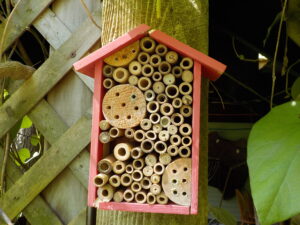The Gardener’s Bane: Slugs, Bugs and Ticks, Oh My!
Posted on Wednesday, June 28, 2023 · Leave a Comment
All gardeners have to contend with a variety of insects and other small pests in the garden – those that attack our plants and those that bite us. Mosquitoes? I can live with them. But ticks? That is another story.
I’ve tried every kind of spray to repel ticks and prevent bites. I haven’t found any that are 100% effective. There are lots of “all natural” ones out there, but it is hard to tell how effective they are. I don’t like sprays with Deet in them, but believe they probably are better at repelling ticks than the herbal applications. But I don’t rely just on repellents.
When I am working in brushy areas I wear long pants: lightweight quick-dry nylon. Then I either tuck the pants into my socks or wear some special tick gaiters. The ones I use are called Lymeez. According to their advertising, they are a mesh treated with EPA-registered micro-encapsulated permethrin tick repellent and closed with Velcro. LL Bean and other suppliers also sell clothing treated with permethrin to kill or repel ticks, mosquitoes and other insects.
From what I have read, permethrin not only repels ticks, it kills them. I have read about “tick tubes” treated with permethrin to kill the ticks on mice – a vector for Lyme. These little tubes contain treated cotton balls that mice bring to their nests, where the permethrin kills the ticks. I plan to get some for my woodpile.
Slugs and shell-covered small snails are always a problem in my garden. I usually keep a jar of soapy water in the garden near my lettuce, which is the preferred treat for these nasty critters. Pick and drown works.
Another garden pest is the Colorado potato beetle. This striped beetle can decimate the leaves of potatoes if you don’t control them early, even killing the plant or reducing your crop. The beetles are yellowish with black stripes, the larvae are beige to red with rows of black dots. The eggs are orange and generally found on the underneath side of the leaves. It is important to pick these pests early as they mature quickly and each female lays many eggs – multiplying their impact quickly if not controlled.
If you have too many potato plants to hand pick them all, there is a biological control called Bt. It is a bacterium that is diluted in water and sprayed on the plants. It is not a contact poison, it needs to be consumed by the larvae when they are young. They sicken, stop eating and die. But you may need to use it for a few years to really solve the problem. There are several different Bt formulas, so be sure you get one labeled for potatoes.

Leaves eaten by striped cucumber beetle
Striped cucumber beetles look a bit like potato beetles, but they are smaller and fast moving. They can strip all the leaves off your vine crops in a single night if they are present in the soil when your cukes or squash-family plants first germinate. You can cover the crops with row covers to keep them away, but they may already be present in the soil. Me? I start my vine crops indoors and only plant them when they have at least a six-inch long vine and can’t be killed by the beetles.

Larvae of parasitic asp on tomato hornworm will kill it
My least favorite pest is the tomato hornworm. Big, up to four inches long, they are aggressive when you pick them up. There is a natural predator, a parasitic wasp that lays eggs in them. So if you see what looks like grains of rice on them, just remove them to a faraway part of the garden. Those “grains of rice” are larvae that will suck them dry and keep them from reproducing. You can make or buy houses for these wasps and other good wasps and hang it on your shed. These are simply a collection of hollow bamboo pieces they can use to for shelter.
A good reason NOT to use insecticides is that they will inadvertently kill good bugs like lady beetles, spiders, praying mantises and more. You’ve probably never seen an assassin bug, but they are relentless killers of bad bugs, sucking them dry.
Many of us grew up thinking that most bugs, beetles, moths and other insects are harmful. For a long time my first inclination on seeing an insect in the garden was to squish it. Not anymore. Mother Nature tries to create a balance that keeps pests from taking over. Unless you know an insect is a pest – think Japanese beetle, rose chafer, striped cucumber beetle – leave it be. It might be the critter that controls others from decimating your garden.

This simple structure provides a place for beneficial solitary wasps to lay eggs
If you want to learn about the bugs you see, you might want to pick up a copy of a nice small paperback called, “Good Bug, Bad Bug: Who’s Who, What They Do, and How to Manage Them Organically” by Jessica Walliser. It is well illustrated and also tells you how you can attract good ones– or even purchase them.
Being an organic gardener means you have to pay attention. Watch for problem pests and try to control them before they can ruin your flowers or veggies. And never use a chemical pesticide as it will throw everything out of balance.
Henry is a lifelong organic
gardener, and a 20-year veteran of the UNH Master
Gardener program. He is the author of 4
gardening books and a
gardening consultant. Reach him at
henry.homeyer@comcast.net.





